
CERTIFICATIONS
- We hereby certify that the products
listed on this certification are original factory made products and are in
conformity with the technical specifications declared by the manufacture.
- USA Patent for Weight mesurement system !

- HYRobotics
is independently audited and certified to be in conformance with ISO 9001
|
ISO 9001 |
CE Certification for
TOPIV Series |
CE Certification for
HIT Series |
CE Certification for
MACH Series |
CE Certification for
MAX Series |
CE Certification for
VECT Series 1 |
CE Certification for
VECT Series 2 |
CE Certification for
Hybrid Series |
CE Certification for
NEXIA Series |
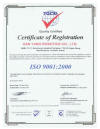 |
 |
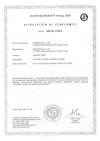 |
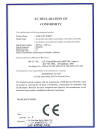 |
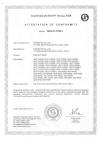 |
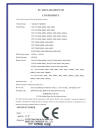 |
 |
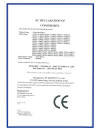 |
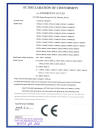 |
ISO 9000
is a standards for quality management systems. ISO 9000 is
maintained by ISO, the International Organization for
Standardization and is administered by accreditation and
certification bodies. Some of the requirements in ISO 9001
(which is one of the standards in the ISO 9000 family) would
include:
- a set of procedures that
cover all key processes in the business;
- monitoring processes to
ensure they are effective;
- keeping adequate records;
- checking output for
defects, with appropriate corrective action where necessary;
- regularly reviewing
individual processes and the quality system itself for
effectiveness; and
- facilitating continual
improvement
HYRobotics
is independently audited and certified to be in conformance with
ISO 9001
- HYRobotics manufacturing
plant is certified with International Standard Organization
9001: ISO 9001.
- ISO 9001 Certified plant
is manufacturing products with optimum process to improve
it's quality to satisfy their customers.
- ISO 9001 Certified
production will ensure each component of robot inspection
form supplier , control process for manufacturing and test
finished products with step by step of ISO 9001 Certified
Step.
CERTIFICATE OF CONFORMITY ( CE
)
- We hereby certify that
the products listed on this certification are original
factory made products and are in conformity with the
technical specifications declared by the manufacture.
CE Mark Requirements for
Machinery
In this document the manufacturer or
authorized representative declares that the machinery is designed and built
according to all applicable European safety standards. It has to be
pointed out that all requirements mainly apply to the safety of the machine and
not to the entire technical system and technology. Safety means safety of
persons, of the environment, of goods.
Definition of Machinery
For the purpose of the directive, 'machinery'
means an assembly of linked parts or components, at least one of which moves,
with the appropriate actuators, control and power circuits, etc., joined
together for a specific application, in particular for the processing,
treatment, moving or packaging of material. The directive does even apply to
machinery that are not stand alone systems. The term 'machinery' also covers an
assembly of machines which, in order to achieve the same end, are arranged and
controlled so that they function as an integrated whole. The individual
components of the machinery do not have to carry the CE Mark. However, some
separately sold components ("safety components, placed on the market
separately") will need to bear the CE Mark.
Additionally the EMC (electromagnetic compatibility) Directive 89/336/EEC has
come into effect since January 1st, 1996. Manufacturers must ensure their
products conform to this strict directive.
Not only must they not emit electromagnetic
disturbances, they must also be immune to them.
Any electrical product that could be construed as having an intrinsic purpose
(i.e. is not simply a component), will have the CE marking to indicate
conformity.
What CE standards are applicable for
machinery?
What standards your machine has to comply with
depends on the machine itself and its use. The standards are so numerous that
usually a database search is required.
The most important harmonized standards which
most likely apply to your machinery are
- EN 60204
- Safety of machinery - Electrical
equipment of machines
- Part 1: General Requirements
- EN 292
- Safety of machinery. Basic terminology.
General principles
- Part 1 and 2
A harmonized standard is a standard which is
harmonized for use in all member states.
The manufacturer retains the responsibility
for certifying the conformity of their machinery to the relevant essential
requirements. Conformity to harmonized standards creates a presumption of
conformity to the relevant essential requirements. It is left to the sole
discretion of the manufacturer, where he feels the need, to have his products
examined and certified by a third party.
Hazard Assessment
The manufacturer is under an obligation to assess
the hazards in order to identify all those which apply to his machine; he must
then design and construct it taking his assessment into account. The assessment
is to be recorded and included in the construction file.
Documentation
Before issuing an EC declaration of conformity it
is essential that the manufacturer or his authorized representative provides a technical construction file. It is not,
however, essential that all documentation be permanently available in a material
manner but it must be made available on demand. If a competent national
authority asks that full documentation be presented, it will suffice that this
documentation is compiled and made available in a reasonable time frame. The documentation need not include detailed
plans of the subassemblies used in manufacturing the machines, unless knowledge
of these is indispensable in order to ascertain conformity with essential safety
requirements.
The technical construction file comprises
- an overall drawing of the machinery
together with drawings of the control circuits
- full detailed drawings, accompanied by
any calculation notes, test results, etc required to check the conformity of
the machinery with the essential safety and health requirements.
- a list of
- the essential requirements of the EC
directive
- standards, and
- other technical specifications, which
were used when the machine was designed
- if he so desires, any technical report or
certificate obtained from a competent body or laboratory
- if he declares conformity with a
harmonized standard which provides therefore, any technical report giving the
results of tests carried out at his choice either by himself or by a
competent body or laboratory
- a description of methods adopted to
eliminate hazards presented by the machinery
- a copy of the instructions for the
machinery.
The above construction file has to be in any
one official language of the EC and will be accepted in other EC countries as
well, even if a different language is spoken there. The maintenance manual may
be required in local language; this differs from case to case, see below. The
operating manual is always needed in local language.
You will find this info in the EC directive
89/392/EEC amended by directive 93/44/EEC Annex 1, 1.7.4: "... On being put into
service, all machinery must be accompanied by a translation of the instructions
in the language of the country in which the machinery is to be used and by the
instructions in the original language. .... By way of derogation of this
requirement, the maintenance instructions for use by specialized personnel
employed by the manufacturer or his authorized representative established in the
Community may be drawn up in only one of the Community languages understood by
that personnel."
You can't write your operating manual as you
like any more. The EC directive lists very specifically what an operating manual
must contain. All machinery must be accompanied by instructions including at
least the following:
- repeat of the information with which the
machinery is marked, together with any appropriate additional information to
facilitate maintenance (e.g. address of the importer, repairers etc.)
- foreseen use of the machinery
- workstations likely to be occupied by
operators
- instructions for safe
- putting into service
- use
- handling, giving the mass of the
machinery and its various parts where they are regularly to be
transported separately
- assembly, dismantling
- adjustment
- maintenance (servicing and repair)
- where necessary, training
instructions.
Where necessary, the instructions should draw
attention to ways in which the machinery should not be used.
Authorized representative
If the manufacturer does not reside in the
European Community, directive 89/392/EEC requires that he must name an
authorized representative established in the EC. This representative noted in
the EC declaration of conformity must be capable of making the construction file
available to competent authorities on demand.
Checking of conformity
How does the CE marking become enforced? The
member states of the European Community are free to choose the way how and when
to check whether a machinery is bearing the CE Mark. Thus each state does it
differently through "competent authorities". Generally no standard procedure
exists to check on the machinery and it may never be checked at all.
The rule for the latest moment to affix the CE
Mark and for issuing the EC declaration of conformity is: The machinery has to
bear the CE Mark at the moment it is given to the user. For standard machinery
this may be the time of purchase or delivery. For special designed equipment or
equipment which is assembled at the customers site, this may be the moment after
having set up the machinery and having put it into operation by the manufacturer
and handing it over to the user. To sum it up: you never know, when you will be
checked. It may be possible to use/sell machinery without CE marking unnoticed
for quite a while. But the user/seller will be in bad shape, if an accident
happens or if he is subject to a routine check. If the machinery bears the CE Mark, local
authorities may ask for the construction file, which is required before issuing
the EC declaration of conformity. The file has to remain available for at least
10 years following the date of manufacture of the machinery. The documentation
has to be delivered in a reasonable time frame, e.g. 7 to 14 days, depending on
the type of documentation. Failure to present the documentation in response of a
duly substantiated request by the competent national authorities may constitute
sufficient grounds for doubting the presumption of conformity with the
requirements of the EC directive.
How to reach EC conformity
The first step is to check, whether your
equipment falls under the scope of the EC directive. If in doubt, you may ask an
expert for a report on it. If the CE Mark requirements apply to your equipment,
you may for instance proceed with these practical steps:
- Make a database search for all European
standards which are applicable to your machinery.
- Check your equipment against these
standards, make a safety analysis (hazard assessment) and keep a written
record of this procedure.
- Make changes to your equipment if
required by the above analysis.
- Compile the construction file.
- Localize the operating manual and if
necessary any maintenance manual. State herein the safety rules with which
the equipment complies. Give notice in the manuals for which purpose the
equipment is built. Give notice which safety hazards may arise and how to
avoid them.
A fast, safe, and economical way to ensure you
are fulfilling the CE Mark requirements is to employ local expertise in this
field, to guide you through the necessary actions to be taken. BICON provides
all services needed. Please refer to our list of those services designed to help
you to get started fast and smooth. |
